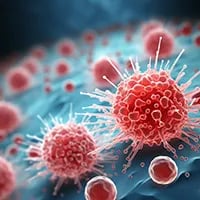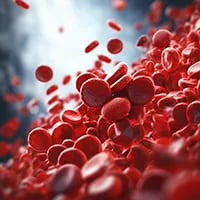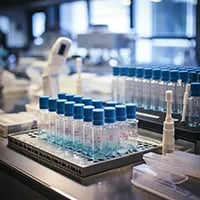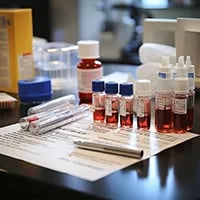Share this
what diseases can be identified through blood sampling?
by James Rudge, PhD, Technical Director, Trajan on Dec 21, 2020 9:00:00 AM
.jpg?width=300&name=shutterstock_293967086%20(1).jpg) Routine blood sampling is critical to identifying health problems early. In this article, you'll learn about diseases diagnosable via blood tests and how they aid healthcare providers in making appropriate treatment interventions. Lab analysis of blood samples provides information about body changes over time and their impact on your health, even when you have no symptoms.
Routine blood sampling is critical to identifying health problems early. In this article, you'll learn about diseases diagnosable via blood tests and how they aid healthcare providers in making appropriate treatment interventions. Lab analysis of blood samples provides information about body changes over time and their impact on your health, even when you have no symptoms.
Why Blood Testing Is Important
Blood tests enable:
- Early Disease Detection: Catching diseases, like cancer, at nascent stages.
- Risk Evaluation: Foreseeing susceptibility to conditions like inherited breast cancer.
- Monitoring: Assessing organ functions and checking medication concentration in the bloodstream.
- Disease Management: Tracking disease progression and evaluating treatment efficacy.
- Prevention: Research on biomarkers can support translational medicine, helping doctors identify imminent health issues, like diabetes, and guiding preventive measures.
- Treatment: Aiding in therapeutic decisions.
Identifying Diseases Through Blood Testing

Cancer: If your doctor suspects you have cancer, a series of tests will be ordered, including a blood test. Apart from blood cancer, blood tests alone can’t be used to determine cancer. The tests only show cancerous proteins, cells, or other substances. Examples of such blood tests include:
- Complete blood count – This blood test determines the number of blood cells in a sample. Blood cancer may be detected using this test because it shows if there are too many or too few of a particular blood cell or the presence of abnormal cells.
- Protein testing – This examines the presence of abnormal immune system proteins often elevated in people with multiple myeloma.
 Heart Disease: When the heart muscles are damaged, the heart releases certain proteins and substances into the bloodstream. Blood tests are performed to measure the levels of these substances circulating in the blood, and can indicate the extent of the damage.
Heart Disease: When the heart muscles are damaged, the heart releases certain proteins and substances into the bloodstream. Blood tests are performed to measure the levels of these substances circulating in the blood, and can indicate the extent of the damage.
The most common blood test used to diagnose heart disease is the cholesterol test, which measures the number of fats in the blood and the risk of developing heart disease. A blood test can also be used to show the triglyceride level, another measure for identifying a patient’s risk of developing heart disease. The normal triglyceride level should be less than 150 mg/dl. Higher levels indicate your body is accumulating more calories than it can burn.
 HIV and AIDS: Several blood tests are used to test for the AIDS virus. They include:
HIV and AIDS: Several blood tests are used to test for the AIDS virus. They include:
- Antibody screening test – It tests for the presence of a protein that the body makes 2-8 weeks after HIV infection. It’s called an ELISA test, and is considered to be very accurate.
- Antigen combination test – This blood test detects the virus earlier than the antibody test. It’s used to check for an HIV antigen protein called p24, which develops 2-4 weeks after infection. The test also shows if the body has developed HIV antibodies.
- Nucleic acid test – Also called an RNA test, this is used to look for HIV 10 days after exposure. The doctor prescribes this test if you’ve developed flu-like symptoms or have a high risk of contracting the virus.
 Hepatitis C: A blood test is used to determine if a person is infected with the Hepatitis C virus. The test is also known as the HCV antibody test; it looks for Hepatitis C virus antibodies in the blood. Other Hepatitis C tests include the HCV RNA test and the HCV genotype test.
Hepatitis C: A blood test is used to determine if a person is infected with the Hepatitis C virus. The test is also known as the HCV antibody test; it looks for Hepatitis C virus antibodies in the blood. Other Hepatitis C tests include the HCV RNA test and the HCV genotype test.
Innovations in Blood Testing: How Blood Tests Can be Performed Today
Venipuncture has been the traditional method for performing blood draws, whereby a phlebotomist punctures a vein in your arm to collect tubes of blood that will be sent to the lab for blood tests.
However, new blood collection methods, such as the finger-prick microsampling method to gather a few drops of capillary blood, have proven effective as alternatives that can provide accurate blood tests results.
This technique, which can be performed with a Mitra® device, is also known as “capillary blood sample collection. The Mitra is a small device with an absorbent tip based on Volumetric Absorptive Microsampling (VAMS® technology designed to absorb a tiny, precise volume of blood.
This approach is less invasive than venipuncture and the dried samples don't require cold storage or shipping, making this approach cost-effective. Also, finger-prick microsampling requires only a small blood volume for analysis.

Devices like the Mitra microsampler make capillary blood collection easier, because they’re portable and user-friendly.
Note: While fingertip capillary blood collection for dried blood testing can be used to replace many tests that previously relied on wet blood samples, it can’t be used to perform a complete blood count, or CBC. This test is used to identify cancerous cells, and still requires a higher volume wet blood sample for analysis.
DBS and VAMS samples have proved effective for:
- Biomarkers – Blood biomarkers are used in early screening for many diseases. DBS-based screening is less invasive and poses minimal discomfort or risk to the patient.
- Comprehensive metabolic panels (CMP) – A group of 14 tests provide information about blood sugar levels, your kidney health, and electrolytes balance. The test determines a patient’s general health status by screening for a variety of conditions, including diabetes, high blood pressure, liver, and kidney disease.
- Enzyme markers – This blood test shows an enzyme’s activity in the body. It detects celiac disease, stroke, and liver cirrhosis.
Analysis of a Blood Sample
Once a blood sample is collected, it’s sent to lab technicians for processing and analysis to help identify diseases. While some diseases require additional testing information to confirm a diagnosis, blood tests can help identify potential problems early, when treatment or lifestyle changes are likely to be most effective.
Understanding what diseases can be found in blood tests empowers individuals to take proactive steps in their healthcare. From early detection to monitoring chronic conditions, blood tests serve as a vital tool in modern medicine.

Share this
- Microsampling (206)
- Research, Remote Research (119)
- Venipuncture Alternative (105)
- Clinical Trials, Clinical Research (83)
- Mitra® Device (73)
- Therapeutic Drug Monitoring, TDM (51)
- Dried Blood Spot, DBS (39)
- Biomonitoring, Health, Wellness (30)
- Infectious Disease, Vaccines, COVID-19 (24)
- Blood Microsampling, Serology (23)
- Omics, Multi-Omics (21)
- Decentralized Clinical Trial (DCT) (20)
- Specimen Collection (18)
- Toxicology, Doping, Drug/Alcohol Monitoring, PEth (17)
- Skin Microsampling, Microbiopsy (14)
- hemaPEN® Device (13)
- Preclinical Research, Animal Studies (12)
- Pharmaceuticals, Drug Development (9)
- Harpera Device (7)
- Industry News, Microsampling News (5)
- Antibodies, MAbs (3)
- Company Press Release, Product Press Release (3)
- Environmental Toxins, Exposures (1)
- July 2025 (1)
- May 2025 (1)
- April 2025 (2)
- December 2024 (2)
- November 2024 (1)
- October 2024 (3)
- September 2024 (1)
- June 2024 (1)
- May 2024 (1)
- April 2024 (4)
- March 2024 (1)
- February 2024 (2)
- January 2024 (4)
- December 2023 (3)
- November 2023 (3)
- October 2023 (3)
- September 2023 (3)
- July 2023 (3)
- June 2023 (2)
- April 2023 (2)
- March 2023 (2)
- February 2023 (2)
- January 2023 (3)
- December 2022 (2)
- November 2022 (3)
- October 2022 (4)
- September 2022 (3)
- August 2022 (5)
- July 2022 (2)
- June 2022 (2)
- May 2022 (4)
- April 2022 (3)
- March 2022 (3)
- February 2022 (4)
- January 2022 (5)
- December 2021 (3)
- November 2021 (5)
- October 2021 (3)
- September 2021 (3)
- August 2021 (4)
- July 2021 (4)
- June 2021 (4)
- May 2021 (4)
- April 2021 (3)
- March 2021 (5)
- February 2021 (4)
- January 2021 (4)
- December 2020 (3)
- November 2020 (5)
- October 2020 (4)
- September 2020 (3)
- August 2020 (3)
- July 2020 (6)
- June 2020 (4)
- May 2020 (4)
- April 2020 (3)
- March 2020 (6)
- February 2020 (3)
- January 2020 (4)
- December 2019 (5)
- November 2019 (4)
- October 2019 (2)
- September 2019 (4)
- August 2019 (4)
- July 2019 (3)
- June 2019 (7)
- May 2019 (6)
- April 2019 (5)
- March 2019 (6)
- February 2019 (5)
- January 2019 (8)
- December 2018 (3)
- November 2018 (4)
- October 2018 (7)
- September 2018 (6)
- August 2018 (5)
- July 2018 (8)
- June 2018 (6)
- May 2018 (5)
- April 2018 (6)
- March 2018 (4)
- February 2018 (6)
- January 2018 (4)
- December 2017 (2)
- November 2017 (3)
- October 2017 (2)
- September 2017 (4)
- August 2017 (2)
- July 2017 (4)
- June 2017 (5)
- May 2017 (6)
- April 2017 (6)
- March 2017 (5)
- February 2017 (4)
- January 2017 (1)
- July 2016 (3)
- May 2016 (1)
- April 2016 (2)



Comments (6)